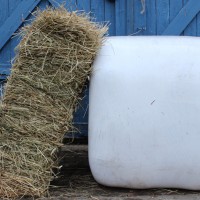Dusty forage cause respiratory disorders

Feeding silage instead of hay is commonly recommended to horses with respiratory disorders. It reduces the amount of respirable particles and allergens to which the stabled horse is exposed and have been shown to maintain clinical remission in horses with COPD (chronic obstructive pulmonary disease). In Sweden, diseases of the respiratory system have been between the third and the sixth most common cause of death in horses. Also in other European countries, diseases of the respiratory system have been a common cause of loss or ailment.
Studies have shown that the amount of respirable dust particles from dusty hay of bad quality was tenfold greater than from non-dusty hay of good quality. Two different grass silages and alfalfa pellets gave significantly less respirable dust particles than the non-dusty hay of good quality. The grass silages had dry matter concentrations of 78 and 50% DM.
Also bedding was tested in this study; wood shavings (specifically sold as bedding for horses) gave more respirable dust particles than straw of good quality. However, wood shavings were significantly less dusty than the non-dusty hay of good quality. Rolled grains gave more dust particles than the hay of good quality.
Viable spores from COPD allergens A. fumigatus, F. rectivirgula and T. vulgaris showed that there was no difference between the silage of 78% DM and the hay of good quality. However, the silage of 50% DM had significantly lower allergens than the hay of good quality. Spores from the dusty hay of bad quality could not be quantified because the Petri dishes they are grown in were overloaded, even when the sampling time was reduced to 5 seconds.
It is important to choose feed of good hygienic quality and when unsure it is possible to send feed samples for analysis, read more about that here. Also straw samples can be sent for analysis and remember that the overall stable environment matters too, horses kept in groups outside with shelter instead of stable is an attractive alternative!
Sara Muhonen, AgrD
References:
Clausen von M, Preisinger R & Kalm E. 1990 Analyse von krankheitsdaten in der deutschen warmblutzucht. Züchtungskunde 62, 167-178.
Egenvall A, Penell JC, Bonnett BN, Olson P & Pringle J. 2006 Mortality of Swedish horses with complete life insurance between 1997 and 2000: variations with sex, age, breed and diagnosis. The Veterinary Record 158, 397-406.
